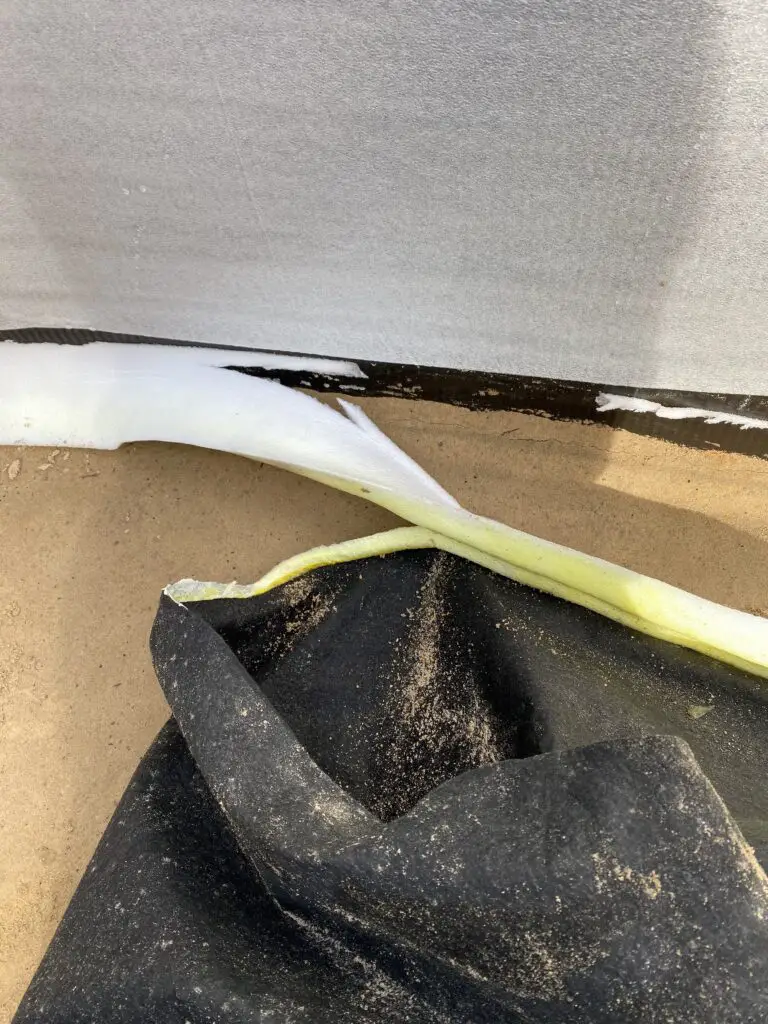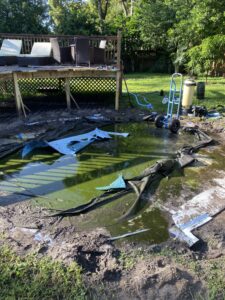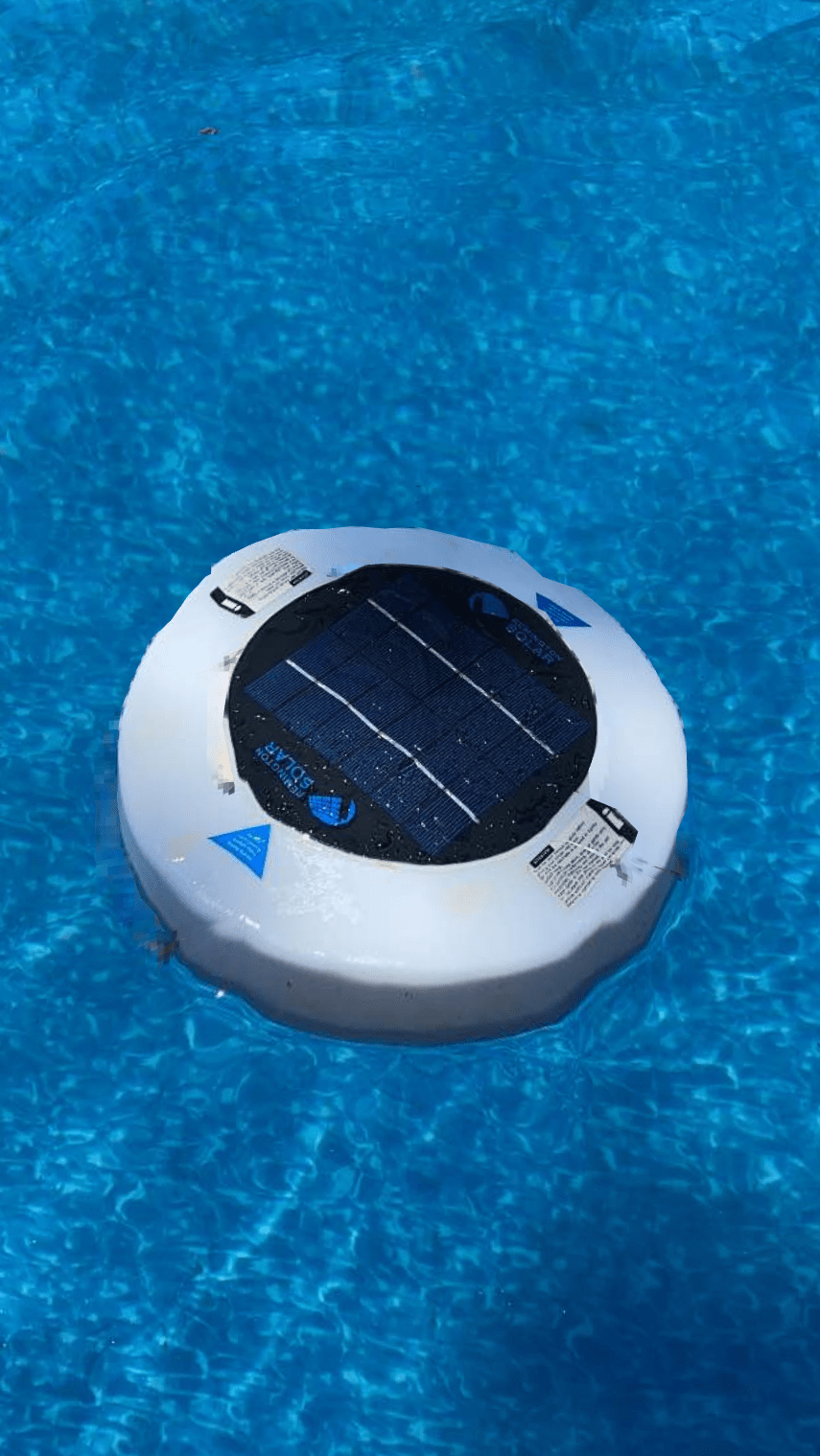In truth, the vast majority of above-ground swimming pools never come down or get taken apart until they rust and die. Some do have to get taken down for reasons like moving to another house, selling it, or upgrading to an inground pool.
NOTE: If your are looking for information on taking down a used OVAL above ground pool, read here.
Every year, a few people contact me to take down an above-ground pool. In the world of do-it-yourself projects though, this is something most homeowners can do themselves. It’s not that strenuous, doesn’t take a lot of knowledge, and only takes a few tools to get the job done.
In the past 35 years as a pool installer, I have probably taken down a few hundred above grounds that were to be saved and re-installed. That’s not many compared to the thousand or so I’ve taken down because they were no longer good(rusted out).
If you have installed as many pools as I have, you become very systematic about it. There are a lot of parts and when those parts go together in a specific pattern, then the install goes much better and easier.
This is the case when disassembling an above-ground pool too. Being systematic is much better than being chaotic about it.
In this article, I am giving a step-by-step method of disassembling a round above-ground.
TOOLS AND MATERIALS NEEDED TO TAKE DOWN AN ABOVE GROUND POOL
1 Cordless screw gun and fittings (For most pools, you will need a #3 Phillips bit and a 5/16 hex head bit but not all)
2 Large adjustable wrench
3 Spray lubricant/penetrant (Like WD-40 or better)
4 Large flat head screwdriver and hammer/rubber mallet
5 Shovel
6 2 pieces of plywood to roll the wall on(or something similar)
7 Utility Knife
8 Hand truck
9 Wasp spray (Wasp nests in above ground pools is very common)
10 Small bags or containers (to hold the screws and smaller parts)
11 Tape, small rope, or whatever needed to hold the parts together
12 Good space to store the pool
13 Water hose (to clean some parts)
THREE THINGS TO KNOW BEFORE TAKING THE POOL DOWN
A Decide whether the pool will be re-used or trashed – There’s a huge difference between taking a pool down that is going to the dump and one that is going back up somewhere.
If you are planning on trashing the pool, then it can come down a lot easier as you don’t have to worry about damaging, organizing, and making sure the parts are all accounted for. And you’ll most likely be using a hammer more.
If your plan is to re-install it elsewhere or sell it, then this will take more time and require more organization.
B If planning on reinstalling the pool, check for rust – Rust is a big issue with above-ground pools. And it’s the number one reason a pool cannot be re-used.
Before going through the trouble of taking the pool down because you are selling or reinstalling it elsewhere, check everywhere for rust, especially the wall of the pool.
Unfortunately, the only way to really know if a pool is too rusty is by inspecting the inside of the pool wall. And the only way to see that is by draining the pool and removing the liner. And with draining the pool and removing the liner, you are pretty committed to finish taking the pool down regardless of its condition.
C Know that the liner CANNOT be re-used – I want to make this very clear. It doesn’t matter if the liner is brand new and has only been in the pool for a week. – The existing liner cannot be reused. Period
For about 30 years, I’ve had to argue this fact and really don’t want to anymore. Just take my word for it (even though you don’t know me lol) and accept the fact that a new liner has to be purchased.
Or you can always go ahead and reuse the existing liner and eventually learn for yourself. The result will be the same though. The pool will have a new liner soon after it goes back up.
26 STEPS TO TAKING DOWN A ROUND ABOVE GROUND SWIMMING POOL
1 Drain the pool – The easiest way to do this is by poking a few holes in the bottom of the pool liner and allow the water to slowly drain into the earth. You can use your pool pole to do this or anything else that will make small holes in the liner.
You can also use a sump pump or your water hose to siphon out most of the water.
2 Locate the wall bolts, remove the upright hiding them, and spray with penetrant – The wall bolts will most likely be fused with their nuts, so although this step is somewhat out of order, you want to get some lubricant/penetrant on the wall bolts and nuts as soon as you can.
In most cases, the bolts that connect the wall together will be hidden behind an upright closest to your skimmer/return openings. Remove the top caps in that area to get to the top seats.
Unscrew the top seats/rails so you can get to the top connector for the upright hiding the wall bolts. Remove the top connector and then remove that upright.
With that upright removed, the wall bolts are easily accessible. Spray them generously and repeatedly with a penetrant like WD-40. Let soak.
3 Remove all top caps to expose the top screws. Spray with lubricant – Just like the wall bolts, the screws used to connect the top rails to the top connectors may be rusty and fused. Spray them all with a penetrant and let them soak.
Gather all the pieces of each top cap, organize, count, and package them for storage or delivery.
NOTE: When removing the top caps, you may encounter some wasps nests. Have some wasp spray handy for this.
4 Get inside the pool and cut out the liner(in pieces) – Using a utility knife, cut the liner out piece by piece and toss it over the wall to be picked up and taken to the trash.
Even though the liner is thin and the pool has no water, it can be very heavy as sometimes the earth will stick to the bottom. Trying to keep the liner in one piece will make it much harder to move and dispose of.
5 Remove what is covering the wall bolts and spray bolt heads with lubricant – Now that the liner is out of the pool, you can access the wall bolts on the inside of the wall.
The wall bolts will be covered by something(to protect the liner from them). Most likely, it will be duct tape running from top to bottom. Remove the tape and spray the bolt heads with a penetrant. Let soak.
6 Cut PVC pipes or remove hoses, then remove skimmer and return fitting from pool wall – If your pool only has the plastic flex hoses connecting the pool to the pump/filter, then that’s easier. Take them off by loosening their hose clamps.
If you have PVC piping connecting the pool to your pump and filter, then you will have to cut the pipes and remove them from the skimmer and return fitting.
Now, remove the skimmer by unscrewing the screws on the inside of the pool. For a widemouth (rectangle) skimmer, there will be eighteen screws.
Remove the return fitting from the wall. Use a large adjustable wrench to loosen the remove the large plastic nut on the outside of the return.
7 Remove ladder or steps – Unscrew/unbolt if attached to the top rail and disassemble what needs to come apart depending on the model.
NOTE: Pool ladders are usually weighted down with something and/or full of water. Find any added weight(behind the steps) and remove. Remove any water in the ladder by tilting on its side.
8 Unscrew and remove all top rails – Now that you’ve allowed some time for their screws to soak in penetrant, you can remove the top rails. Some may be rusty and hard to take apart. Be patient and hit with more penetrant if needed.
Gather all the top rails. Count, organize, and package for storage or delivery
9 Remove any ground pad or foam bottom – Liner guards have become very popular. If you have one, it’s time to take it up.
In many cases, the liner guard/pad cannot be reused. This is because earth, roots, and algae can attach to it and make it hard to use again. If your pad has a lot of stuff stuck to it, you can either let it dry and beat the sticking debris off of it or just fold it up and throw it away.
Liner pads/guards aren’t that expensive, so it may be better to just buy a new one(along with your new liner) than have to deal with the old dirty existing one.
If you have foam boards taped together for the pool bottom, now is the time to remove all of that. Foam boards are not usually reusable but will depend on their condition.
If the foam boards are misshaped or questionable in any way, do yourself a favor and just throw them away. It can be too much of a pain to try to reuse them.
10 Remove foam coving or earth coving

Foam coving has also gotten quite popular. In most cases, foam coving gets torn apart when removing from the pool wall, so don’t plan on reusing it.
If your cove is made from earth or sand, use a shovel and move the cove away from the pool wall. This will allow you to be able to roll the wall up later.
11 Loosen and take out wall bolts – It’s time to start taking the pool apart. First thing to do here is to take the wall apart. This is an important step.
Taking an above-ground pool down is something one person can do but it is very helpful to have two people to get the wall bolts off. With one person on the inside of the pool and one on the outside, remove each wall bolt and nut.
Some of these bolts can be fused together (especially towards the bottom), so take your time and be gentle. You absolutely don’t want to strip any of them. If they aren’t coming off, stop, spray with more penetrant and wait.
NOTE: In extreme cases, some of the bolts won’t come apart and will need to be cut off. This is a pain to do but has to be done. It’s very important to not cut the pool wall when cutting off any wall bolts.
Once taken off, count, organize, and package the bolts, nuts, washers, and/or wall bars
12 Secure one end of the open wall with shovel/s – It’s time to start rolling the wall up, but now that the bolts are not connecting the wall together, you have two ends of the wall exposed.
Using shovels( or anything that will keep the wall up and in place), secure one end of the pool wall upright. You do this so that end of the wall won’t fall down while you are rolling up the other end.
13 Unscrew and take off a couple of top connectors closest to the wall opening – In order to start rolling the wall up, you have to remove the top pieces of the pool frame.
You only want to remove a couple of them as you roll the wall though so the wall stays up everywhere except where you are rolling it up.
Take off a few of the top connectors in the direction of where you will be rolling the wall.
14 Remove top stabilizer bars, plastic coping, and/or bead channel closet to wall opening – Remove the rest of the parts that are on top of the pool wall. You are now ready to start rolling the wall up.
Remember to not take too many of these parts apart. If you take too many of them apart too far ahead of the roll, then the wall will start falling down.
15 Begin to roll the wall up and remove top pieces as you go – Lay down two pieces of plywood or something flat on the floor of the pool in front of the wall opening. Start rolling the wall in a somewhat tight circle.
Pull the wall out of the bottom track as you go. This can be tricky as the wall can get stuck in the track. You may have to shake the wall or even pry it out of the bottom track. When prying, be gentle.
As you roll the wall in a spiral, remove the top pieces as you go (step 14) Removing them as you go will make it easier to roll the wall without it falling down.
16 Remove uprights as you go – As you roll the wall up and out of the bottom track, the uprights of the pool will be exposed and trying to stand on their own.
Before they fall over, unscrew or pry them from the bottom connector plates as you go. Don’t do too many of them at once as they are helping keep the wall from falling too.
Continue to roll the wall up by moving the plywood in place and removing the top pieces and uprights as you go (steps 15 and 16) and taking the wall out of the bottom track. The wall roll will move around the inside of the pool as you roll it up.
Do this until you reach the other end of the pool wall. Your wall will now be rolled up in a fairly tight roll. All of the top parts of the pool and the uprights will be removed.
17 When the wall is completely rolled up, secure the roll with tape or rope – The wall is now in a roll but needs to be secured. Do this by taping or roping all the way around the roll. This will make it easier to move.
Use a hand truck/dolly to move the wall. The wall will be heavy and awkward to move. It’s best to have two people when moving it.
18 Collect top rails, top caps, top connectors, top stabilizer bars, coping, and uprights – Group each part together organize, and package for storage or delivery.
19 Find all bottom track pieces and bottom connectors and spray clean with a water hose – At this stage, the only part of the pool that is left is the bottom track and bottom connector plates. It’s time to gather them up.
Since these parts can be in the dirt, it’s very important to make sure and find them all. You wouldn’t think that parts can get lost, but believe me, it’s super common to miss a piece of bottom track or bottom connector because it was hidden in the ground.
Once you have gathered them all, take them somewhere and wash them off using a water hose. These pieces can get caked with dirt, so cleaning them out is a good idea. And count these pieces over and over to make sure you get them all.
20 Group and package cleaned bottom pieces for storage or delivery – Congratulations. The pool is now completely disassembled.
21 Drain filter and pump of any water – This will make it easier to move.
22 Remove any PVC piping and keep for storage – If you have plastic hoses instead, take them off and keep them for storage or delivery.
23 Disconnect the pump from its power source – In most cases, this will just be unplugging the pump from an outside receptacle. If your pump is hardwired though, it will take removing some wires from a timer or power box.
If you have a timer or any other electric component, make sure to add that to the pool for storage or delivery.
24 Before transporting or storing, count each piece of the pool and make sure nothing is missing – Are you tired of me saying to count the pieces yet? Well, count all the pieces one final time to make sure. I can’t tell you how common it is for a piece or two to be missing with a used above-ground pool.
25 If storing, find a good clean place and store in an organized way – If you think for one minute that parts of a pool won’t come up missing while in storage, then think again.
Stored above-ground pool parts have a way of growing legs and walking away. Having a good clean storage place and storing the pool in a very organized way may prevent these things from growing legs and coming up missing.
And the longer a pool is stored, the greater the chance that something will come up missing. So, if your intention is to store for a long period, then store very, very well. It can be impossible to find replacement parts. Jus’ Sayin.
26 If transporting, make sure all parts go and are secure for the trip – By the time you load everything up, the pool will take up more space than you think. And it will be more awkward than you think too.
The pump and filter are very bulky and awkward. So is whatever ladder or steps you have. And these two things take up a lot of room in a pick-up truck or van or trailer.
Be more organized than you think you have to be when transporting a used above-ground pool. And secure everything well. Personally, I’ve had ladders and small pieces of a pool fly out during transport. And that really sucks.
ADDITIONAL NOTES, OBSERVATIONS, AND WARNINGS ABOUT TAKING DOWN AN ABOVE GROUND POOL
A Sand filters are very heavy and awkward – I don’t like sand filters to begin with, but moving them can really suck. Use a hand truck and whoever is available to help.
In most cases, moving the sand filter will be the hardest part of the takedown.
B Some ladders/steps are full of water. Drain as best you can – And with some of them, you can’t get all of the water out of them. Do what you can and drain them in any way you can figure out. It will make it easier to move.
C Bottom parts can be easily missed. Count parts at least twice – Pieces of the bottom track and bottom connector plates are the most common part missing. Count, count, and count again.

D There will be the same number of top rails, top caps, top connectors plates, uprights, bottom connectors, and bottom track pieces – As an example, a 24′ round pool usually has sixteen parts of each. This really helps to know when making sure you have all the parts.
E Secure all screws in bags or containers. They can be misplaced easily – The good part here is that you can find replacement hardware pretty easily. But why have to when you can do what it takes to keep what was used.
F The rolled pool wall can be very awkward to move. Move it to an area to clean any dirt still on it to make it lighter – While rolling up the pool wall, you may notice that some dirt will stick to it at the bottom.
Cleaning the dirt off of the wall will make it much lighter and easier to transport.
G Wasps, spiders, and frogs like to live within an above-ground pool. Be aware of this –
H Do not try to save the liner. It will be a waste of your time – Yeah, mic drop on this.
I Be careful taking resin parts apart. Some can crack or break easily – Some resin parts are going to crack or break when you take the pool apart. It’s just a fact. Just try not to break the parts so bad that they can’t be reused. In most cases, broken resin parts can be reused which is good.
J You can reuse the patio blocks/stones used to level the pool – Most DIYers and almost all professional pool installers will use some type of patio stone or block under each upright for leveling. If you want, you can dig them out and re-use them as well. As long as they are made of a cement product, they will last for years and are definitely re-usable.
K If the pool has wall foam or foam coving, each most likely cannot be re-used. Don’t bother trying to keep them.
L If the used pool has a dog house for the equipment or a storage container made of wood, it’s not usually worth the effort to take them. So, unless they are in really good shape, leave that stuff there.



Is this basically the same as taking down a Oval shape pool?
Yes basically except an oval has a lot more parts to it. And a lot more buried parts.
I will be removing a pool to reuse it. If the foam cove is stuck on with a glue or other adhesive, whatbis the best way to remove then so we can roll the pool wall up?
Tear it off. Most of it will tear off. What is left will not be in the way of rolling up the wall.
Thanks for the thorough instructions! Cutting up the liner is brilliant!
Right?